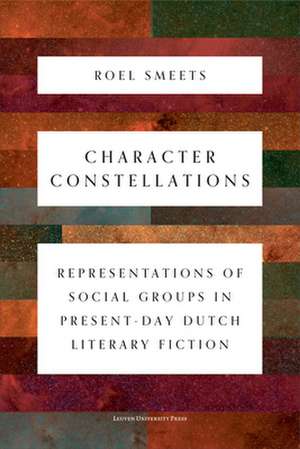Character Constellations
Autor Roel Smeetsen Limba Engleză Paperback – 15 noi 2021
Showcasing what character-based critiques of literary representation gain by integrating data-driven methods into the practice of critical close reading, Character Constellations contributes to societal debates on cultural representation and identity and the role fiction and art have in those debates.
Preț: 249.15 lei
Nou
Puncte Express: 374
Preț estimativ în valută:
47.68€ • 50.13$ • 39.39£
47.68€ • 50.13$ • 39.39£
Carte tipărită la comandă
Livrare economică 17 aprilie-01 mai
Preluare comenzi: 021 569.72.76
Specificații
ISBN-13: 9789462702950
ISBN-10: 9462702950
Pagini: 252
Dimensiuni: 155 x 229 x 15 mm
Greutate: 0.39 kg
Editura: Leuven University Press
ISBN-10: 9462702950
Pagini: 252
Dimensiuni: 155 x 229 x 15 mm
Greutate: 0.39 kg
Editura: Leuven University Press
Cuprins
Chapter 1: Introduction 1.1 Introduction: Character Constellations
1.1.1 Example: Character Constellations in Joost Zwagerman¿s De buitenvrouw (1994) and Robert Vuijsje¿s Alleen maar nette mensen (2008) 1.1.2 Delineation of the Study and Research Question 1.1.3 Character Studies 1.1.4 Characterization and Character Types 1.1.5 The One Versus the Many 1.2. Critique of Representation 1.2.1 Representation and Ideology 1.2.2 Critiques of Representation in Dutch Literature 1.3. Cultural Analytics 1.3.1 Debates on Distant versus Close Reading 1.3.2 Modeling in Cultural Analytics 1.4 Methodological Background 1.4.1 Tools: Narratology and Network Analysis 1.4.2 Corpus and Data 1.4.3 Previous Research on Corpus and Dataset 1.5 Structure of the Book and Instruction for Reading
Chapter 2: Data 2.1 Introduction: Descriptive Statistics 2.2 Information on the Authors 2.3 Demographic Metadata on the Characters 2.4 (In)Dependence of Variables 2.5 Relational Information
2.6 Interpretation of Descriptive Statistics
Chapter 3: Centrality 3.1 Introduction: Narrative Cornerstones 3.2 Centrality in Network Theory 3.3 Centrality in Narratology 3.4 Method for Extracting Character Networks 3.4.1 Characters as Nodes 3.4.2 Character Relations as Edges 3.4.3 Automatic Extraction of Character Networks 3.5 Model I: Character Rankings 3.5.1 Results Multiple Regression Analysis 3.5.2 Close Reading: Centrality, Gender, and Descent in Özcan Akyol¿s Eus (2012) 3.6 Conclusion to this Chapter
Chapter 4: Community 4.1 Introduction: Narrative Connections 4.2 Community in Network Theory 4.2.1 Community Detection 4.2.2 Homophily 4.3 Community in Narratology 4.3.1 Syntagmatic and Paradigmatic Collectives 4.3.2 Dialogic Interaction and Polyphony 4.4 Model I: Community Detection 4.4.1 Clauset-Newman-Moore and Girvan-Newman Algorithms 4.4.2 Kernighan-Lin Bisection Algorithm 4.4.3 Close Reading: Communities in Philip Huff ¿s Niemand in de stad (2012) 4.5 Model II: Homophily 4.5.1 Dyad Assortativity 4.5.2 Close Reading: Homophily in Mensje van Keulen¿s Liefde heeft geen hersens (2012) 4.6 Conclusion to this Chapter
Chapter 5: Conflict 5.1 Introduction: Narrative Clashes 5.2 Conflict in Network Theory 5.3 Conflict in Narratology 1 5.4 Model I: Hierarchies in One-on-one Conflicts 5.4.1 Conflict Scores 5.4.2 Results of Multiple Linear Regression 5.4.3 Close Reading: Class Conflicts between Two Characters in Bart Koubaäs De Brooklynclub (2012) 5.5 Model II: Social Balance in Triangular Conflicts 5.5.1 Automatic Modeling of Social Balance in Enemy/Friend triads 5.5.2 Social Balance in Leon de Winter¿s VSV, of daden van onbaatzuchtigheid 5.5.3 Social Imbalance in Tommy Wieringäs Dit zijn de namen 5.6 Conclusion to this Chapter
Chapter 6: Conclusion 6.1 Findings of the Book 6.2 Public Debates on Literary Representation 6.3 Future Research
Appendix A: Statistical tests Appendix B: Distribution of Relational Roles Appendix C: Main and Interaction Effects Appendix D: Pearson Correlations Notes References
1.1.1 Example: Character Constellations in Joost Zwagerman¿s De buitenvrouw (1994) and Robert Vuijsje¿s Alleen maar nette mensen (2008) 1.1.2 Delineation of the Study and Research Question 1.1.3 Character Studies 1.1.4 Characterization and Character Types 1.1.5 The One Versus the Many 1.2. Critique of Representation 1.2.1 Representation and Ideology 1.2.2 Critiques of Representation in Dutch Literature 1.3. Cultural Analytics 1.3.1 Debates on Distant versus Close Reading 1.3.2 Modeling in Cultural Analytics 1.4 Methodological Background 1.4.1 Tools: Narratology and Network Analysis 1.4.2 Corpus and Data 1.4.3 Previous Research on Corpus and Dataset 1.5 Structure of the Book and Instruction for Reading
Chapter 2: Data 2.1 Introduction: Descriptive Statistics 2.2 Information on the Authors 2.3 Demographic Metadata on the Characters 2.4 (In)Dependence of Variables 2.5 Relational Information
2.6 Interpretation of Descriptive Statistics
Chapter 3: Centrality 3.1 Introduction: Narrative Cornerstones 3.2 Centrality in Network Theory 3.3 Centrality in Narratology 3.4 Method for Extracting Character Networks 3.4.1 Characters as Nodes 3.4.2 Character Relations as Edges 3.4.3 Automatic Extraction of Character Networks 3.5 Model I: Character Rankings 3.5.1 Results Multiple Regression Analysis 3.5.2 Close Reading: Centrality, Gender, and Descent in Özcan Akyol¿s Eus (2012) 3.6 Conclusion to this Chapter
Chapter 4: Community 4.1 Introduction: Narrative Connections 4.2 Community in Network Theory 4.2.1 Community Detection 4.2.2 Homophily 4.3 Community in Narratology 4.3.1 Syntagmatic and Paradigmatic Collectives 4.3.2 Dialogic Interaction and Polyphony 4.4 Model I: Community Detection 4.4.1 Clauset-Newman-Moore and Girvan-Newman Algorithms 4.4.2 Kernighan-Lin Bisection Algorithm 4.4.3 Close Reading: Communities in Philip Huff ¿s Niemand in de stad (2012) 4.5 Model II: Homophily 4.5.1 Dyad Assortativity 4.5.2 Close Reading: Homophily in Mensje van Keulen¿s Liefde heeft geen hersens (2012) 4.6 Conclusion to this Chapter
Chapter 5: Conflict 5.1 Introduction: Narrative Clashes 5.2 Conflict in Network Theory 5.3 Conflict in Narratology 1 5.4 Model I: Hierarchies in One-on-one Conflicts 5.4.1 Conflict Scores 5.4.2 Results of Multiple Linear Regression 5.4.3 Close Reading: Class Conflicts between Two Characters in Bart Koubaäs De Brooklynclub (2012) 5.5 Model II: Social Balance in Triangular Conflicts 5.5.1 Automatic Modeling of Social Balance in Enemy/Friend triads 5.5.2 Social Balance in Leon de Winter¿s VSV, of daden van onbaatzuchtigheid 5.5.3 Social Imbalance in Tommy Wieringäs Dit zijn de namen 5.6 Conclusion to this Chapter
Chapter 6: Conclusion 6.1 Findings of the Book 6.2 Public Debates on Literary Representation 6.3 Future Research
Appendix A: Statistical tests Appendix B: Distribution of Relational Roles Appendix C: Main and Interaction Effects Appendix D: Pearson Correlations Notes References
